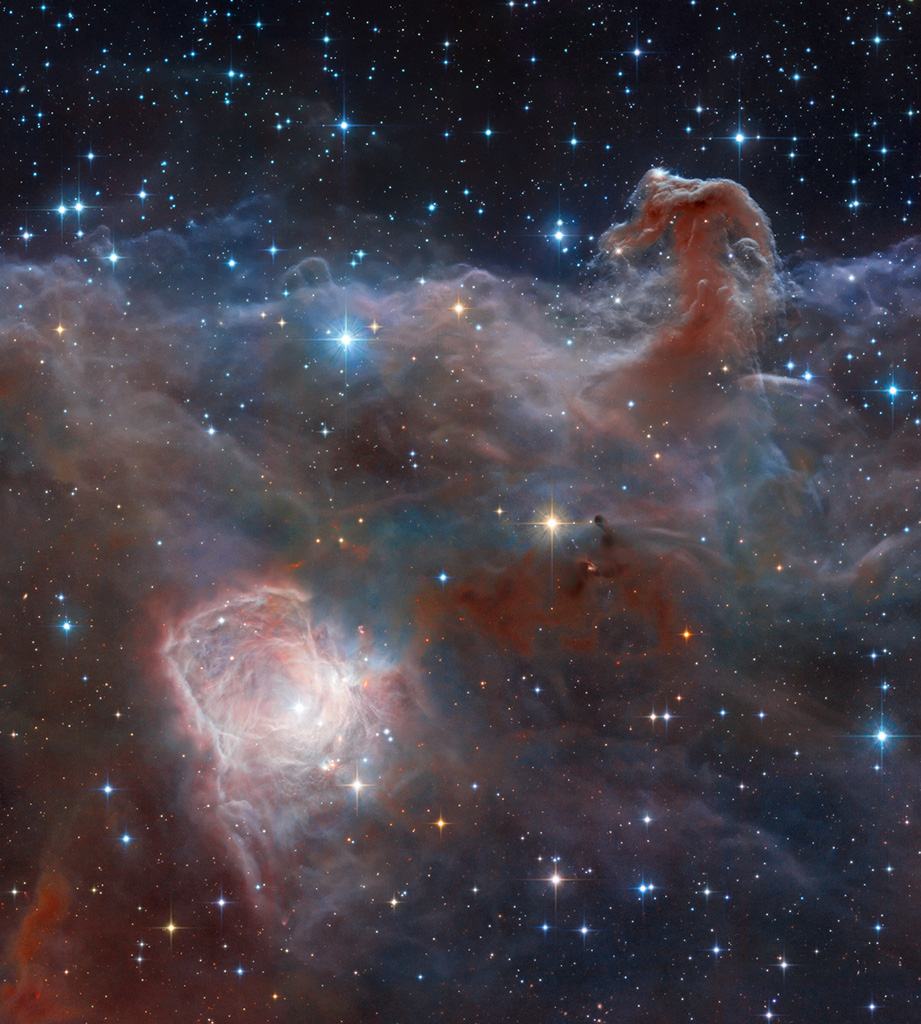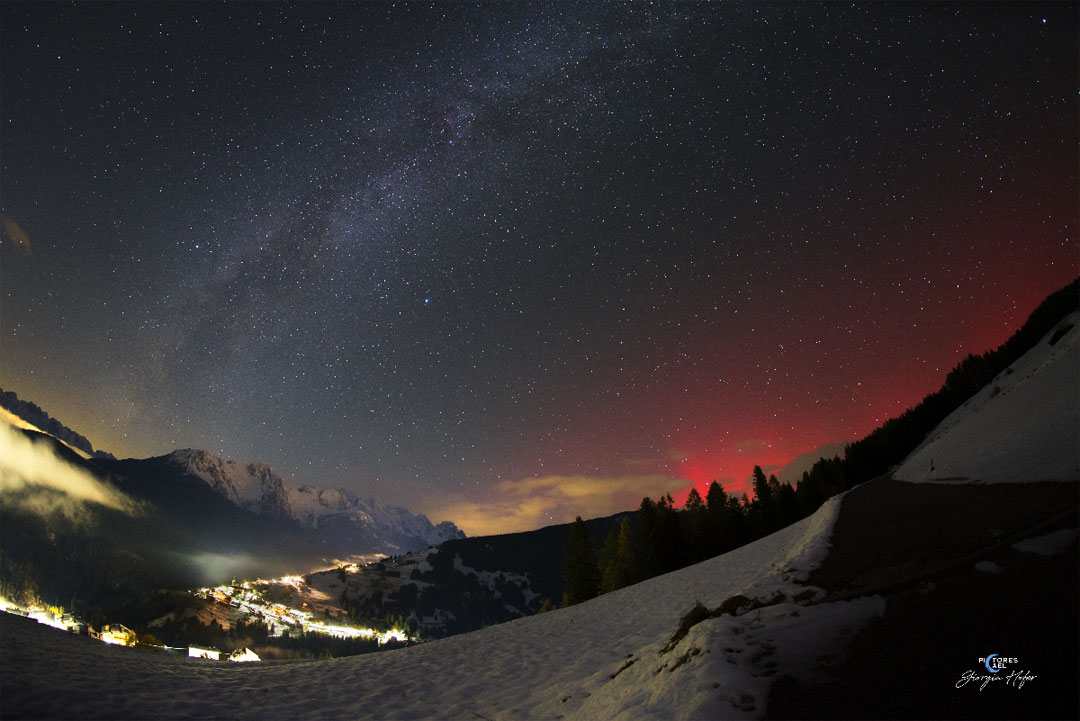
|
| Title: NASA pics | |
| Grapevine50sRoost > ~GENERAL~ > GENERAL DISCUSSION | Go to subcategory: |
| Author | Content |
|
zxxlyzq
|
|
|
Date Posted:09/03/2018 12:10 PMCopy HTML Composition and Processing: Robert Gendler Image Data: ESO, VISTA, HLA, Hubble Heritage Team (STScI/AURA) Explanation: Combined image data from the massive, ground-based VISTA telescope and the Hubble Space Telescope was used to create this wide perspective of the interstellar landscape surrounding the famous Horsehead Nebula. Captured at near-infrared wavelengths, the region's dusty molecular cloud sprawls across the scene that covers an angle about two-thirds the size of the Full Moon on the sky. Left to right the frame spans just over 10 light-years at the Horsehead's estimated distance of 1,600 light-years. Also known as Barnard 33, the still recognizable Horsehead Nebula stands at the upper right, the near-infrared glow of a dusty pillar topped with newborn stars. Below and left, the bright reflection nebula NGC 2023 is itself the illuminated environs of a hot young star. Obscuring clouds below the base of the Horsehead and on the outskirts of NGC 2023 show the tell-tale far red emission of energetic jets, known as Herbig-Haro objects, also associated with newborn stars. |
|
|
Rockymz
|
Share to:





 #91
#91
|
|
Re:NASA pics Date Posted:13/08/2025 7:29 AMCopy HTML Image Credit: Data: Hubble Legacy Archive, Processing: Robert Gendler Explanation: What lies in the heart of Orion? Trapezium: four bright stars, that can be found near the center of this sharp cosmic portrait. Gathered within a region about 1.5 light-years in radius, these stars dominate the core of the dense Orion Nebula Star Cluster. Ultraviolet ionizing radiation from the Trapezium stars, mostly from the brightest star Theta-1 Orionis C powers the complex star forming region's entire visible glow. About three million years old, the Orion Nebula Cluster was even more compact in its younger years and a dynamical study indicates that runaway stellar collisions at an earlier age may have formed a black hole with more than 100 times the mass of the Sun. The presence of a black hole within the cluster could explain the observed high velocities of the Trapezium stars. The Orion Nebula's distance of some 1,500 light-years make it one of the closest candidate black holes to Earth. |
|
|
Megan57
|
Share to:





 #92
#92
|
|
Re:NASA pics Date Posted:13/08/2025 6:07 AMCopy HTML
|
|
|
Rockymz
|
Share to:





 #93
#93
|
|
Re:NASA pics Date Posted:12/08/2025 6:45 AMCopy HTML Image Credit & Copyright: Marcin Rosadziński Explanation: Where are all of these meteors coming from? In terms of direction on the sky, the pointed answer is the constellation of Perseus. That is why the meteor shower that peaks tonight is known as the Perseids -- the meteors all appear to come from a radiant toward Perseus. In terms of parent body, though, the sand-sized debris that makes up the Perseids meteors come from Comet Swift-Tuttle. The comet follows a well-defined orbit around our Sun, and the part of the orbit that approaches Earth is superposed in front of Perseus. Therefore, when Earth crosses this orbit, the radiant point of falling debris appears in Perseus. Featured here, a composite image taken over six nights and containing over 100 meteors from 2024 August Perseids meteor shower shows many bright meteors that streaked over the Bieszczady Mountains in Poland. This year's Perseids, usually one of the best meteor showers of the year, will compete with a bright moon that will rise, for many locations, soon after sunset. |
|
|
Megan57
|
Share to:





 #94
#94
|
|
Re:NASA pics Date Posted:12/08/2025 6:05 AMCopy HTML Amazing Rocky x |
|
|
Rockymz
|
Share to:





 #95
#95
|
|
Re:NASA pics Date Posted:11/08/2025 7:56 AMCopy HTML Image Credit & Copyright: Giorgia Hofer Explanation: What was that red glow on the horizon last night? Aurora. Our unusually active Sun produced a surface explosion a few days ago that sent out a burst of electrons, protons, and more massive charged nuclei. This coronal mass ejection (CME) triggered auroras here on Earth that are being reported unusually far south in Earth's northern hemisphere. For example, this was the first time that the astrophotographer captured aurora from her home country of Italy. Additionally, many images from these auroras appear quite red in color. In the featured image, the town of Comelico Superiore in the Italian Alps is visible in the foreground, with the central band of our Milky Way galaxy seen rising from the lower left. What draws the eye the most, though, is the bright red aurora on the far right. The featured image is a composite with the foreground and background images taken consecutively with the same camera and from the same location |
|
|
Megan57
|
Share to:





 #96
#96
|
|
Re:NASA pics Date Posted:11/08/2025 7:11 AMCopy HTML
|
|
|
Rockymz
|
Share to:





 #97
#97
|
|
Re:NASA pics Date Posted:10/08/2025 7:51 AMCopy HTML Image Credit & Copyright: Ruslan Merzlyakov (astrorms) Explanation: What's that strange light down the road? Dust orbiting the Sun. At certain times of the year, a band of sun-reflecting dust from the inner Solar System appears prominently just after sunset -- or just before sunrise -- and is called zodiacal light. Although the origin of this dust is still being researched, a leading hypothesis holds that zodiacal dust originates mostly from faint Jupiter-family comets and slowly spirals into the Sun. Recent analysis of dust emitted by Comet 67P, visited by ESA's robotic Rosetta spacecraft, bolsters this hypothesis. Pictured when climbing a road up to Teide National Park in the Canary Islands of Spain, a bright triangle of zodiacal light appeared in the distance soon after sunset. Captured on June 21, 2019, the scene includes bright Regulus, the alpha star of the constellation Leo, standing above center toward the left. The Beehive Star Cluster (M44) can be spotted below center, closer to the horizon and also immersed in the zodiacal glow. |
|
|
Megan57
|
Share to:





 #98
#98
|
|
Re:NASA pics Date Posted:10/08/2025 7:05 AMCopy HTML That’s a different one |
|
|
Rockymz
|
Share to:





 #99
#99
|
|
Re:NASA pics Date Posted:09/08/2025 8:52 AMCopy HTML Image Credit: NASA, ESA, David Jewitt (UCLA) et al. - Processing; Joseph DePasquale (STScI) Explanation: Discovered on July 1 with the NASA-funded ATLAS (Asteroid Terrestrial-impact Last Alert System) survey telescope in Rio Hurtado, Chile, 3I/ATLAS is so designated as the third known interstellar object to pass through our Solar System. It follows 1I/ʻOumuamua in 2017 and the comet 2I/Borisov in 2019. Also known as C/2025 N1, 3I/ATLAS is a comet. A teardrop-shaped cloud of dust, ejected from its icy nucleus warmed by increasing sunlight, is seen in this sharp image from the Hubble Space Telescope captured on July 21. Background stars are streaked in the exposure as Hubble tracked the fastest comet ever recorded on its journey toward the inner solar system. An analysis of the Hubble image indicates the solid nucleus, hidden from direct view, is likely less that 5.6 kilometers in diameter. This comet's interstellar origin is clear from its orbit, determined to be an eccentric, highly hyperbolic orbit that does not loop back around the Sun and will return 3I/ATLAS to interstellar space. Not a threat to planet Earth, the inbound interstellar interloper is now within the Jupiter's orbital distance of the Sun, while its closest approach to the Sun will bring it just inside the orbital distance of Mars. |
|
|
Megan57
|
Share to:





 #100
#100
|
|
Re:NASA pics Date Posted:09/08/2025 6:10 AMCopy HTML
|
|
|
Rockymz
|
Share to:





 #101
#101
|
|
Re:NASA pics Date Posted:08/08/2025 7:46 AMCopy HTML Image and Text Credit: Bradley E. Schaefer Explanation: One of the all-time historic skyscapes occured in July 1054, when the Crab Supernova blazed into the dawn sky. Chinese court astrologers first saw the Guest Star on the morning of 4 July 1054 next to the star Tianguan (now cataloged as Zeta Tauri). The supernova peaked in late July 1054 a bit brighter than Venus, and was visible in the daytime for 23 days. The Guest Star was so bright that every culture around the world inevitably discovered the supernova independently, although only nine reports survive, including those from China, Japan, and Constantinople. This iPhone picture is from Signal Hill near Tucson on the morning of 26 July 2025, faithfully re-creates the year 1054 Dawn of the Crab, showing the sky as seen by Hohokam peoples. The planet Venus, as a stand-in for the supernova, is close to the position of what is now the Crab Nebula supernova remnant. Step outside on a summer dawn with bright Venus, and ask yourself "What would you have thought in ancient times when suddenly seeing the Dawn of the Crab?" |
|
|
Megan57
|
Share to:





 #102
#102
|
|
Re:NASA pics Date Posted:08/08/2025 5:48 AMCopy HTML
|
|
|
Rockymz
|
Share to:





 #103
#103
|
|
Re:NASA pics Date Posted:07/08/2025 8:18 AMCopy HTML Image Credit & Copyright: Ron Brecher Explanation: This stunning starfield spans about three full moons (1.5 degrees) across the heroic northern constellation of Perseus. It holds the famous pair of open star clusters, h and Chi Persei. Also cataloged as NGC 869 (right) and NGC 884, both clusters are about 7,000 light-years away and contain stars much younger and hotter than the Sun. Separated by only a few hundred light-years, the clusters are both 13 million years young based on the ages of their individual stars, evidence that both clusters were likely a product of the same star-forming region. Always a rewarding sight in binoculars or small telescopes, the Double Cluster is even visible to the unaided eye from dark locations |
|
|
Megan57
|
Share to:





 #104
#104
|
|
Re:NASA pics Date Posted:07/08/2025 6:50 AMCopy HTML
|
|
|
Rockymz
|
Share to:





 #105
#105
|
|
Re:NASA pics Date Posted:06/08/2025 8:14 AMCopy HTML Image Credit & Copyright: Fritz Helmut Hemmerich Explanation: What's that green streak in front of the Andromeda galaxy? A meteor. While photographing the Andromeda galaxy in 2016, near the peak of the Perseid Meteor Shower, a small pebble from deep space crossed right in front of our Milky Way Galaxy's far-distant companion. The small meteor took only a fraction of a second to pass through this 10-degree field. The meteor flared several times while braking violently upon entering Earth's atmosphere. The green color was created, at least in part, by the meteor's gas glowing as it vaporized. Although the exposure was timed to catch a Perseid meteor, the orientation of the imaged streak seems a better match to a meteor from the Southern Delta Aquariids, a meteor shower that peaked a few weeks earlier. Not coincidentally, the Perseid Meteor Shower peaks next week, although this year the meteors will have to outshine a sky brightened by a nearly full moon. |
|
|
Megan57
|
Share to:





 #106
#106
|
|
Re:NASA pics Date Posted:06/08/2025 6:00 AMCopy HTML
|
|
|
Rockymz
|
Share to:





 #107
#107
|
|
Re:NASA pics Date Posted:05/08/2025 8:29 AMCopy HTML Image Credit: NASA, ESA, CSA, STScI, JWST Explanation: Why is this nebula so complex? The Webb Space Telescope has imaged a nebula in great detail that is thought to have emerged from a Sun-like star. NGC 6072 has been resolved into one of the more unusual and complex examples of planetary nebula. The featured image is in infrared light with the red color highlighting cool hydrogen gas. Study of previous images of NGC 6072 indicated several likely outflows and two disks inside the jumbled gas, while the new Webb image resolves new features likely including one disk's edge protruding on the central left. A leading origin hypothesis holds that the nebula's complexity is caused or enhanced by multiple outbursts from a star in a multi-star system near the center. |
|
|
Megan57
|
Share to:





 #108
#108
|
|
Re:NASA pics Date Posted:05/08/2025 5:56 AMCopy HTML
|
|
|
Rockymz
|
Share to:





 #109
#109
|
|
Re:NASA pics Date Posted:04/08/2025 8:46 AMCopy HTML Image Credit & Copyright: Ogle et al. Explanation: What are these gigantic blue arcs near the Andromeda Galaxy (M31)? Discovered in 2022 by amateur astronomers, the faint arcs -- dubbed SDSO 1 -- span nearly the same angular size as M31 itself. At first, their origin was a mystery: are they actually near the Andromeda Galaxy, or alternatively near to our Sun? Now, over 550 hours of combined exposure and a collaboration between amateur and professional astronomers has revealed strong evidence for their true nature: SDSO 1 is not intergalactic, but a new class of planetary nebula within our galaxy. Dubbed a Ghost Planetary Nebula (GPN), SDSO 1 is the first recognized member of a new subclass of faded planetary nebulas, along with seven others also recently identified. Shown in blue are extremely faint oxygen emission from the shock waves, while the surrounding red is a hydrogen-emitting trail that indicates the GPN's age. |
|
|
Megan57
|
Share to:





 #110
#110
|
|
Re:NASA pics Date Posted:04/08/2025 6:50 AMCopy HTML
|
|
|
Rockymz
|
Share to:





 #111
#111
|
|
Re:NASA pics Date Posted:03/08/2025 8:55 AMCopy HTML Image Credit & Copyright: Andre van der Hoeven Explanation: In about a week the Perseid Meteor Shower will reach its maximum. Grains of icy rock will streak across the sky as they evaporate during entry into Earth's atmosphere. These grains were shed from Comet Swift-Tuttle. The Perseids result from the annual crossing of the Earth through Comet Swift-Tuttle's orbit, and are typically the most active meteor shower of the year. Although it is hard to predict the level of activity in any meteor shower, in a clear dark sky an observer might see a meteor a minute. This year's Perseids peak just a few days after full moon, and so some faint meteors will be lost to the lunar skyglow. Meteor showers in general are best seen from a relaxing position, away from lights. Featured here is a meteor caught exploding during the 2015 Perseids above Austria next to the central band of our Milky Way Galaxy. |
|
|
Megan57
|
Share to:





 #112
#112
|
|
Re:NASA pics Date Posted:03/08/2025 5:44 AMCopy HTML
|
|
|
Rockymz
|
Share to:





 #113
#113
|
|
Re:NASA pics Date Posted:02/08/2025 8:25 AMCopy HTML Image Credit & Copyright: Daniel Korona Explanation: Taken on July 29 and July 30, a registered and stacked series of exposures creates this dreamlike view of a northern summer night. Multiple firefly flashes streak across the foreground as the luminous Milky Way arcs above the horizon in the Sierra de Órganos national park of central Mexico, The collection of bright streaks aligned across the sky toward the upper left in the timelapse image are Delta Aquariid meteors. Currently active, the annual Delta Aquarid meteor shower shares August nights though, overlapping with the better-known Perseid meteor shower. This year that makes post-midnight, mostly moonless skies in early August very popular with late night skygazers. How can you tell a Delta Aquariid from a Perseid meteor? The streaks of Perseid meteors can be traced back to an apparent radiant in the constellation Perseus. Delta Aquariids appear to emerge from the more southerly constellation Aquarius, beyond the top left of this frame. Of course, the bioluminescent flashes of fireflies are common too on these northern summer nights. But how can you tell a firefly from a meteor? Just try to catch one. |
|
|
Megan57
|
Share to:





 #114
#114
|
|
Re:NASA pics Date Posted:02/08/2025 6:03 AMCopy HTML Looks like an object from a parachute amazing |
|
|
Rockymz
|
Share to:





 #115
#115
|
|
Re:NASA pics Date Posted:01/08/2025 7:46 AMCopy HTML Image Credit & Copyright: Peter Bresseler Explanation: A small, dark, nebula looks isolated near the center of this telescopic close-up. The wedge-shaped cosmic cloudlet lies within a relatively crowded region of space though. About 7,000 light-years distant and filled with glowing gas and an embedded cluster of young stars, the region is known as M16 or the Eagle Nebula. Hubble's iconic images of the Eagle Nebula include the famous star-forming Pillars of Creation, towering structures of interstellar gas and dust 4 to 5 light-years long. But this small dark nebula, known to some as a Bok globule, is a fraction of a light-year across. The Bok globule stands out in silhouette against the expansive background of M16's diffuse glow. Found scattered within emission nebulae and star clusters, Bok globules are small interstellar clouds of cold molecular gas and obscuring dust that also form stars within their dense, collapsing cores. |
|
|
Megan57
|
Share to:





 #116
#116
|
|
Re:NASA pics Date Posted:01/08/2025 6:43 AMCopy HTML
|
|
|
Rockymz
|
Share to:





 #117
#117
|
|
Re:NASA pics Date Posted:31/07/2025 7:37 AMCopy HTML Image Credit: Ben Godson (University of Warwick) Explanation: A long time ago in a galaxy 50 million light-years away, a star exploded. Light from that supernova was first detected by telescopes on planet Earth on July 14th though, and the extragalactic transient is now known to astronomers as supernova 2025rbs. Presently the brightest supernova in planet Earth's sky, 2025rbs is a Type Ia supernova, likely caused by the thermonuclear detonation of a white dwarf star that accreted material from a companion in a binary star system. Type Ia supernovae are used as standard candles to establish the distance scale of the universe. The host galaxy of 2025rbs is NGC 7331. Itself a bright spiral galaxy in the northern constellation Pegasus, NGC 7331 is often touted as an analog to our own Milky Way. |
|
|
Megan57
|
Share to:





 #118
#118
|
|
Re:NASA pics Date Posted:31/07/2025 5:58 AMCopy HTML
|
|
|
Rockymz
|
Share to:





 #119
#119
|
|
Re:NASA pics Date Posted:30/07/2025 8:42 AMCopy HTML Image Credit & Copyright: Andrea Vanoni Explanation: Our Sun frequently erupts in loops. Hot solar plasma jumps off the Sun's surface into prominences, with the most common type of prominence being a simple loop. The loop shape originates from the Sun's magnetic field, which is traced by spiraling electrons and protons. Many loops into the Sun's lower corona are large enough to envelop the Earth and are stable enough to last days. They commonly occur near active regions that also include dark sunspots. The featured panel shows four loops, each of which was captured near the Sun's edge during 2024 and 2025. The images were taken by a personal telescope in Mantova, Italy and in a very specific color of light emitted primarily by hydrogen. Some solar prominences suddenly break open and eject particles into the Solar System, setting up a space weather sequence that can affect the skies and wires of Earth. |
|
|
Megan57
|
Share to:





 #120
#120
|
|
Re:NASA pics Date Posted:30/07/2025 6:43 AMCopy HTML Was going today looks like an eye before I read the info. Amazing |
























 Amazing Rocky
Amazing Rocky







 Amazing Rocky
Amazing Rocky 
